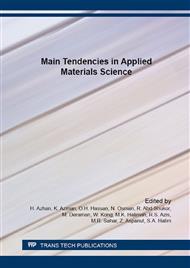[1]
C. A. C. Sequeira, M. D. F. Santos, Introduction to Polymer Electrolyte Materials, in: C. Sequeira and D. Santos (Eds), Polymer Electrolytes: Fundamentals and Applications, Woodhead Publishing Limited, Cambridge, 2010, pp.1-11.
DOI: 10.1533/9781845699772.1.3
Google Scholar
[2]
S.A. Hashmi, Supercapacitors: An Emerging Power Source, Natl. Acad. Sci. Letter 27 (2004) 27-46.
Google Scholar
[3]
A. S. A. Khiar, R. Puteh, A. K. Arof, Conductivities Studies of a Chitosan-Based Polymer Electrolyte, Physica B 373 (2006) 23-27.
DOI: 10.1016/j.physb.2005.10.104
Google Scholar
[4]
Jie, R., Hongye, F., Tianbin, R., Weizhong, Y., Preparation, Characterization and Properties of Binary and Ternary Blends with Thermoplastic Starch, Poly(Lactic Acid) and Poly(Butylene Adipate-Co-Terephtalate), Carbohyd. Polym. 77 (2009) 576-582.
DOI: 10.1016/j.carbpol.2009.01.024
Google Scholar
[5]
M. Yamagata, K. Soeda, S. Ikebe, S. Yamazaki, M. Ishikawa, Chitosan-Based Gel Electrolyte Containing an Ionic Liquid for High-Performance Nonaqueous Supercapacitors, Electrochim. Acta (2012) 1-6.
DOI: 10.1016/j.electacta.2012.05.073
Google Scholar
[6]
M. J. A. Shiddiky, A. A. J. Torriero, Application of Ionic Liquids in Electrochemical Sensing Systems, Biosens. Bioelectron. 26 (2011) 1775-1787.
DOI: 10.1016/j.bios.2010.08.064
Google Scholar
[7]
W. Lu, K. Henry, C. Turchi, J. Pellegrino, Incorporating Ionic Liquid Electrolytes into Polymer Gels for Solid-State Ultracapacitors, J. Electrochem. Soc. 155(5) (2008) 361-367.
DOI: 10.1149/1.2869202
Google Scholar
[8]
P. Wassersoheid, T. Welton, Ionic Liquids in Synthesis, Wiley-VCH Verlog GmbH & Co. Weiheim, (2003).
Google Scholar
[9]
A. S. A. Khiar, A. K. Arof, Electrical Properties of Starch/Chitosan-NH4NO3, WASET 59 (2011) 23-27.
Google Scholar
[10]
A. S. Samsudin, W. Khairul, M. I. N. Isa, Characterization on the Potential of Carboxyl Methylcellulose for Application as Proton Conducting Biopolymer Electrolytes, J. Non-Cryst. Solids 358 (2011) 1104-1112.
DOI: 10.1016/j.jnoncrysol.2012.02.004
Google Scholar
[11]
M. L. H. Rozali, A. S. Samsudin, M. I. N. Isa, Ion Conducting Mechanism of Carboxy Methylcellulose Doped With Ionic Dopant Salicylic Acid Based Solid Polymer Electrolytes, Int. J. Appl. Sci. Tech. 2(4) (2012) 113-121.
Google Scholar
[12]
A. S. Samsudin, M. I. N. Isa, Structural and Ionic Transport Study on Carboxyl Methylcellulose Doped NH4Br: New Type of Biopolymer electrolytes, J. Appl. Sci. 12 (2) (2012) 174-179.
DOI: 10.3923/jas.2012.174.179
Google Scholar
[13]
M. Z. A. Yahya, A. K. Arof, Effect of Oleic Acid Plasticizer on Chitosan–Lithium Acetate Solid Polymer Electrolytes, Eur. Polym. J. 39 (2003) 897-902.
DOI: 10.1016/s0014-3057(02)00355-5
Google Scholar
[14]
Z. Yue, J. M. G. Cowie, Synthesis and Characterization of Ion Conducting Cellulose Esters with PEO Side Chains, Polymer 43 (2002) 4453–4460.
DOI: 10.1016/s0032-3861(02)00284-7
Google Scholar
[15]
N.K. Idris, N.A. N Aziz, M.S. M Zambri, N. A Zakaria, M.I.N. Isa, Ionic Conductivity Studies of Chitosan-Based Polymer Electrolytes Doped with Adipic Acid, Ionics 15 (2009) 643-646.
DOI: 10.1007/s11581-009-0318-4
Google Scholar
[16]
D. R. MacFarlane, P. Meakin, A. Bishop, D. McNaughton, J. M. Rosalie, M. Forsyth, FTIR Study of Ion-Pairing Effects in Plasticized Polymer Electrolytes, Electrochim. Acta 40 (1995) 2333–2337.
DOI: 10.1016/0013-4686(95)00188-k
Google Scholar
[17]
D.K. Pradhan, R. N. P. Choudhary, B. K. Samantaray, Studies of Dielectric Relaxation and AC Conductivity Behaviour of Plasticized Polymer Nanocomposite Electrolytes, Int. J. Electrochem. Sci. 3 (2008) 597 - 608.
DOI: 10.1016/s1452-3981(23)15547-7
Google Scholar


